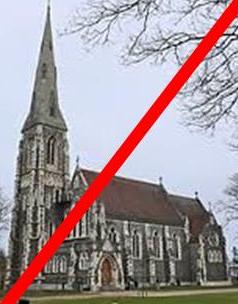Or rather UK in CPH. See some of the traces Britain and Britons have left in Copenhagen. The tour is compact, to and from Nørreport, and in some 45 minutes we’ll get an overview of the Danish-British relationship for some 200 years. For like all brothers or neighbours we’ve fought, we’ve bought and taught.

Meetingpoint: Fiolstræde 44, in front of a big grey building called “Kosmopol”. 55.682607,12.571851. It’s right on the corner on Nørreport. This is also where we end up some 1.5 kms or 4921 feet later.
Duration: About 45 minutes. Covers 200 years of history.
Prices: Monday-Friday: 125 DKK pr. person, Saturday-Sunday: At least 1500 DKK, but with groups with 12 persons or more it’s just 125 DKK a person.
Groupsize: 1-35 persons.

The most obvious place to show UK in DK would of course be St. Alban’s church which really is a piece of England in Copenhagen. Very aptly the address is Churchillparken 11, named in 1965 after the person of the century.

St. Albans church was inaugurated in 1887 by the prince of Wales, Edward VII. At the time the British empire was more than 825 times bigger than tiny little Denmark, so it was a big deal that Edward married the Danish princess Alexandra in 1863. As a way to celebrate the union the church was built by the Danish architect Ludvig “school” Fenger and the English Arthur Blomfield who built many churches in England and the Royal College of Music in London. The walls are made of Danish stone, the roof tiles from Shropshire. (Britain on top!)
The church is inclusive Anglican: Christmas carols and cucumber sandwiches and kind Christianity.


Died in Copenhagen 1882
The W of B&W
We also do not go to either Christianshavn or Holmens kirkegård -graveyard where one of the most influential Britons in Denmark lies. William Wain (1819-82) was born in Bolton, became an engineer and found a job on a Danish postal boat. His talent was recognized and he worked for the Danish fleet before partnering up with a mechanic, Burmeister. They formed B&W shipbuilding company that also made diesel engines, bridges and floating docks. In the heyday of B&W it was the largest workplace in Denmark employing more than 6,000 persons. B&W building filled out a lot of Christianshavn and Refshaleøen, where one can go high roping in a huge hall where ships were built.

On a silly note. We really like the UK and named quite a lot of roads after British persons or places:
Applebys Plads (Peter Appleby, England, ropemaker)
David Balfours gade (Skotland, shipbuilder)
Churchillparken
Doris Lessings vej
Mitchellsgade (Alexander Mitchell, Skotland. Made stockings)
William Wains gade (England, engineer. Councilor. Got the Merit in gold)
Virginia Woolfs vej
Aberdeengade, Bedfordsvej, Boltonvej, Bristol Allé, Corkgade, Derbyvej, Dover Passage, Englandsvej, Etonsvej, Hastingsvej, Hendonsvej, Ilfordsvej, Kingstonvej, Oxford Allé, Portlandsvej, Southamptongade, Stratfordvej, Windsorvej
